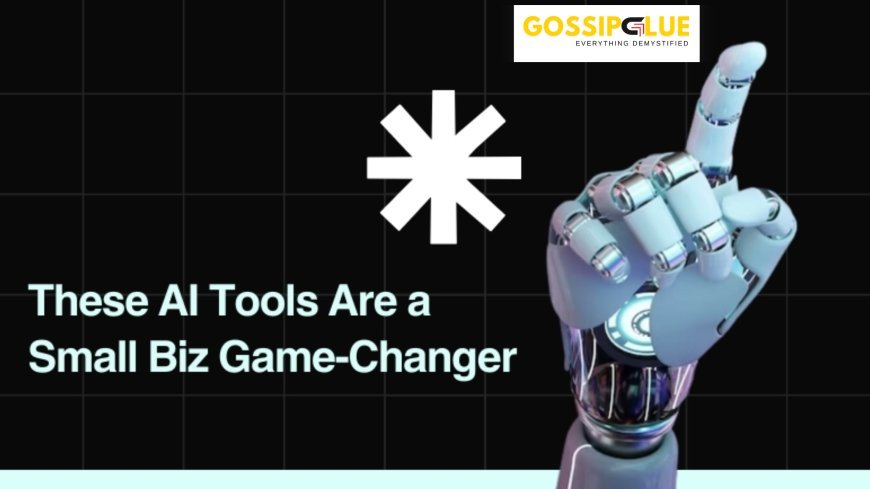How AI Tools Can Automate 70% of Your Business Tasks (Without Hiring More Staff)
Discover how AI tools for small businesses can automate up to 70% of daily tasks. Save time, reduce costs, and grow smarter with artificial intelligence.

Imagine Having a Digital Assistant That Never Sleeps
A few months ago, I sat across from a friendlets call him Rohanwho runs a boutique marketing agency. Over coffee, he told me how hed recently slashed his teams workload by 70% without hiring anyone new. AI did it, he said casually, like it was no big deal.
As someone who loves tech but also understands the stress of juggling ten roles in a small business, I had to dig deeper.
The truth is, AI tools for small businesses arent just for big tech companies anymore. Theyre becoming the not-so-secret weapon for smart entrepreneurs who want to work less, earn more, and finally stop drowning in repetitive tasks.
So, whether you're a solopreneur, run a small team, or you're just tech-curious, lets break down how artificial intelligence can automate a major chunk of your business and free you up to focus on what actually matters.
What Kind of Tasks Can AI Automate for Small Businesses?
Lets get one thing clearAI isnt magic. But it is incredibly good at doing the kinds of tasks you probably hate: repetitive, time-consuming, low-value work that clogs your day.
Here are just a few examples of how AI tools are transforming daily operations:
Customer support: Chatbots like Tidio or Intercom can handle FAQs, book appointments, and even escalate complex issues automatically.
Email marketing: Tools like Mailchimp and Constant Contact use AI to personalize content, optimize send times, and segment audiences with zero manual input.
Scheduling: AI assistants such as Clara or Motion can automatically schedule meetings, manage calendars, and send remindersno back-and-forth required.
Bookkeeping: QuickBooks and Zoho Books use AI to categorize expenses, flag unusual activity, and generate reports in seconds.
Social media: Tools like Buffer or Predis.ai create and schedule posts, analyze engagement, and suggest content based on trendsall powered by artificial intelligence.
Now imagine stitching all these together. Thats where the real time savings happen.
How AI Tools Work Together to Save Time
Think of AI not as a single app but as an ecosystem. When multiple tools talk to each other, the result is seamless automation across your entire business.
For instance:
A lead captured through your website chatbot (AI Tool #1)
gets automatically added to your CRM (AI Tool #2)
which then triggers a personalized email series (AI Tool #3)
and schedules a follow-up meeting if they engage (AI Tool #4).
Without lifting a finger, your small business just ran a multi-touch marketing campaign while you were sleeping.
This isn't hypotheticalits happening right now in thousands of small businesses.
Do You Need to Be a Tech Expert to Use AI Tools?
Absolutely not.
This is one of the biggest myths that keeps small business owners on the sidelines. Most modern AI tools for small businesses are built with non-tech users in mind. If you can use Google Docs or Instagram, you can use AI.
Many tools come with:
Simple onboarding
Step-by-step tutorials
Plug-and-play templates
You dont need coding skills or an IT background. You just need the curiosity to try, and the patience to test what works for your business.
And honestly? The earlier you start exploring, the further ahead youll be. Especially with the way AI trends are movingfast and wide.
AI Doesnt Replace YouIt Amplifies You
One concern I hear a lot is: Will AI replace my job? Or worse, Will I lose the human touch in my business?
Heres the truth: AI tools dont replace youthey amplify your impact.
Lets say you run a graphic design studio. AI wont replace your creativity, but it can handle:
Quoting clients
Following up on invoices
Generating initial drafts or moodboards
That frees you up to focus on design, client relationships, and strategy. The human part. The irreplaceable part.
Real-World Example: The Cafe That Went Digital Overnight
A small cafe near my homerun by a couple in their 50sstarted using AI tools during the pandemic. They used:
ChatGPT to write daily social media captions
Canva's AI to generate simple menu designs
Squares AI-powered analytics to understand customer behavior
Otter.ai to transcribe their team meetings
Within 3 months, they reported a 35% increase in efficiency and saved over ?30,000 in monthly labor costs. No layoffs. Just smarter systems.
Thats the power of tools for small businesses when used right.
Getting Started: Tools Id Recommend to Test the Waters
Here are a few friendly, low-risk AI tools to explore:
Notion AI Great for writing, brainstorming, and task management
Zapier Connects different apps and automates workflows
ChatGPT Perfect for customer support replies, content creation, and even basic coding
Grammarly Polishes your emails, blogs, and documents with AI-driven suggestions
Looka AI logo and branding design for new businesses
Start with one or two, integrate slowly, and scale as you grow confident.
Conclusion: The Future Is NowAnd It's Automated
Heres the deal: You dont have to wait for some perfect moment to start using AI.
Whether you're running a one-person shop or managing a small team, these AI tools for small businesses can help you reclaim your time, reduce burnout, and focus on growth.
Automation isnt just a nice-to-have anymoreits the smart move forward. And the best part? You dont need to be an IT genius to use it.
Try one tool this week. Just one.
You might be surprised how much lighter your workload feels by Friday.





































